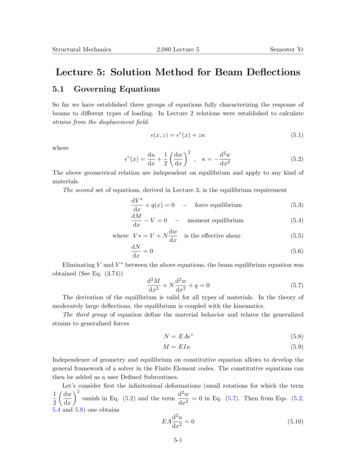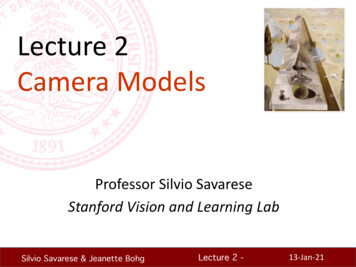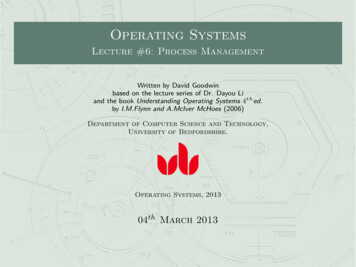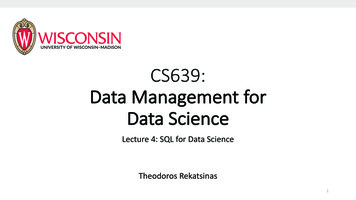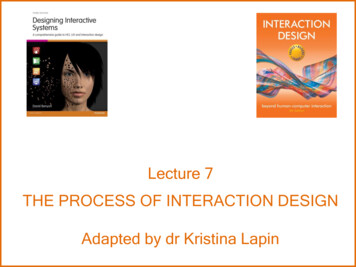
Transcription
Lecture 7THE PROCESS OF INTERACTION DESIGNAdapted by dr Kristina Lapin
Overview What is involved in Interaction Design?– Importance of involving users– Degrees of user involvement– What is a user-centered approach?– Four basic activities Framework for needs analysis: PACT Some practical issues––––Who are the users?What are ‘needs’?Where do alternatives come from?How to choose among alternatives?– How to integrate interaction design activities in other lifecycle models?www.id-book.com2
What is involved in InteractionDesign? It is a process:– a goal-directed problem solving activity informed byintended use, target domain, materials, cost, and feasibility– a creative activity– a decision-making activity to balance trade-offs Generating alternatives and choosing between themis key Four approaches: user-centered design, activitycentered design, systems design, and genius designSaffer (2010)www.id-book.com3
Design approaches1. User centered design– The users know best what they need and theyare the designer's source of knowledge– The role of the designer – translate users'needs and goals to the design decisions2. Activity-centred design– Highlights the activities surrounding the task– The user is still important but more theactivities are analysed instead of needs andobjectives4
Design approaches System design– A structured, rigorous and holistic designapproach– Highlights a context– appropriate for complex systems Rapid expert design (genius design)– Based on the experience of a designer– User’s role – to evaluate the designer’s ideas the user is not involved to a design process itself5
Importance of involving users Expectation management– Realistic expectations– No surprises, no disappointments– Timely training– Communication, but no hype Ownership– Make the users active stakeholders– More likely to forgive or accept problems– Can make a big difference to acceptance and successof productwww.id-book.com6
Degrees of user involvement Member of the design team–Full time: constant input, but lose touch with users–Part time: patchy input, and very stressful–Short term: inconsistent across project life–Long term: consistent, but lose touch with users Newsletters and other dissemination devices–Reach wider selection of users–Need communication both ways User involvement after product is released Combination of these approacheswww.id-book.com7
Research on user involvement The benefits of the user study outweigh the costs (Kujalaet al., 2000). Other results are more ambiguous Subramanyam et al(2010)8
Research on user involvement User involvement can have a negative impacton the project (Heinbokel et al, 1996):– Users generate complex ideas halfway throughthe project and wants to include them too late.– In some cases, users are afraid of losing theirjobs and running unconstructive– Users are unpredictable and understandingdesign principles require significant changes inalmost the last moment– User-conceit may lead to stress and causeunnecessary conflict Designing multimedia systems, to high userinfluence can suppress the innovativesolutions9
What is a user-centered approach?User-centered approach is based on:– Early focus on users and tasks: directly studying cognitive, behavioral, anthropomorphic &attitudinal characteristics– Empirical measurement: users’ reactions and performance to scenarios, manuals,simulations & prototypes are observed, recorded and analysed– Iterative design: when problems are found in user testing, fix them and carry outmore testswww.id-book.com10
Some practical issues Who are the users? What do we mean by ‘needs’? How to generate alternatives How to choose among alternatives How to integrate interaction designactivities with other lifecycle models?www.id-book.com11
Who are the users/stakeholders? Not as obvious as you think:– those who interact directly with the product– those who manage direct users– those who receive output from the product– those who make the purchasing decision– those who use competitor’s products Three categories of user (Eason, 1987):– primary: frequent hands-on– secondary: occasional or via someone else– tertiary: affected by its introduction, or will influence its purchasewww.id-book.com12
Who are the stakeholders?Check-out operators Suppliers Local shopownersCustomersManagers and ownerswww.id-book.com13
What do we mean by ‘needs’? Users rarely know what is possible Users can’t tell you what they ‘need’ to help themachieve their goals Instead, look at existing tasks:– their context– what information do they require?– who collaborates to achieve the task?– why is the task achieved the way it is? Envisioned tasks:– can be rooted in existing behaviour– can be described as future scenarioswww.id-book.com14
Activities and technologiesRequirementsActivities incontextsTechnologiesPeopleOpportunities15
User needs analysisPACTanalysis People Activities Context of use Technologies16
Physical differences Physical characteristics: height, weight Senses: sight, hearing, touch, smell, tasteSource of images: An innocent visit to a Thailand ATM sparks a new meme17
Physical differences Colour blindness– inability to distinguish red and greencolours affects 8% males Short-sightedness, longsightedness Hearing and finger dexterityimpairements Large fingers vs small buttons18
Psychological differences Different spatial abilities– Good ability help easier navigate inwebsites– Designers should design for people withpoor ability Provide good signs and clear directions– Language differences– Cultural differences19
Mental model The understanding andknowledge of using IT– Incomplete people understand someparts better that others– unstable people can forget detailsNorman’s system image(Benyon, 2013, p. 31) Develop throughinteracting with systems20
Social differences the reason for use technologies– The goals and motivations in using technology Beginner, intermediate and expert users Motivations to learn and use particularsystem– beginner needs to be guided– experts use a system regularly and learn allsorts of details– intermediate need to remember how to use21
USER NEEDS ANALYSIS:PERSONAS AND SCENARIOS
Different experience levels[1] Chapter 3. Beginners, intermediates, experts23
Beginners Need extra help fro the program until theybecame intermediates They may not recall from use to useexactly which command is needed to acton a particular object,– but they will definitely remember therelationships between objects and actions.
Intermediates need access to tools.– They don’t need scope and purpose explainedto them because they already know thesethings– tooltips know how to use reference materials.– They are motivated to dig deeper and learn,as long as they don’t have to tackle too muchat once
Experts demand faster access to their regularworking set of tools, which may be quitelarge.– want shortcuts to everything seek to learn more and to see moreconnections between their actions and theproduct’s behavior and representation. appreciate new, powerful features.
PeoplePACTanalysis Activities Context of use Technologies27
Activities Temporal aspectsCooperationComplexitySafety-criticalThe nature of contentTikslinis projektavimas Naudotojų tipai28
Activities Temporal aspects– frequency Frequent tasks – easy to do Infrequent tasks – easy to learn or remember how to do– Time pressure Quiet or busy– Single or continuous actions Can be interrupted?– If Yes – let user find their place– Acceptable response time29
Activities Cooperation– One or more users?– For collaborative activities Awareness Coordination Communication30
Activities Complexity– Well-defined task can be accomplished by steo by step design– for a vague activity people have to be able to browse aroundsee different types of informationmove from one think to another 31
Activities Safety-critical aspects– any mistake could result in in an injury orserious accident– designers must pay attention to ensuring thatmistakes do not have a serious effect Designers must– think what happens when people makemistakes and errors– design for that circumstances32
Activities: Content Data requirements– What is input? large/modest/small amount of required data?– How to input?– What is output? alphanumerical data, video records, other media good content:– accurate, up to date, relevant, good presented33
PACTanalysis People Activities Context of use Technologies34
The physical context Environment in which activity happens Physical environment– temperature, humidity, atmospheric pressure,lightlevels, noise, .35
Social contexts Social environment– privat issues– individual or groupactivity36
Organisational contexts Changes intechnologies altercommunication andpower structures Automation can haveaffects– suxh as deskilling37
PACTanalysis People Activities Context of use Technologies38
Technologies Input devices– switches and buttons facilitate instructions take up space– for alphanumerical input – keyboards39
Technologies Input devices– touch screens– pointing devices, e.g. mouse, stylus– trackball– joystickMicrosoft surface40
Technologies Input devices– gestures– QR codesMicrosoft Kinnect41
Output technologiesFlexible organic light-emitting diodeHaptic technologies2D and 3D printers42
Communication Between people and between devices– Bandwidth and speed are critical– Wired with fibre-optic cables The fastest communication– Wireless, wifi quite limited in range need to be within a few metres 4G fast and wide coverage– Bluetooth, NFC43
Content Good content– accurate, up to date, relevant and well presented Characteristics of the data influence inputmethods– Barcodes – for data that does not change often– Touchscreens – for a few options to choose from– Speech input if there is no noise and few commands to enter44
Scoping the design problemwith PACT User needs is a right mix–of technologies–to support activities–being undertaken by people–in different contexts45
Four basic activities inInteraction Design1. Establishing requirements2. Designing alternatives3. Prototyping4. Evaluatingwww.id-book.com46
A simple interaction design lifecyclemodelExemplifies a user-centered design approachwww.id-book.com47
User centered design (UCD)Image from the Ergonomen.ch49
How to integrate interaction designin other models Integrating interaction design activities in lifecyclemodels from other disciplines needs careful planning Several software engineering lifecycle models havebeen considered Integrating with agile software development ispromising– it stresses the importance of iteration– it champions early and regular feedback– it handles emergent requirements– it aims to strike a balance between flexibility and structurewww.id-book.com50
A simple interaction design lifecyclemodelEstablishingneeds andrequirementsEvaluation(Re)designDevelopment ofinteractiveprototypeExemplifies a user-centered design approach51Production
Star model(Hartson ir Hix, 1989)Task analysis,function analysisImplementationEvaluationDeveloping theprototypeimplementationConceptual presentationformal representation52
How to integrate interaction designlifecycles with SE models Lifecycle models from other disciplines Agile software development promising– have development and design running in separatetracks– maintain a coherent vision of the interfacearchitecture53www.id-book.com
The usability engineering lifecycle(D.54Deborah J. Mayhew & Associates 2011
Agile -use-it/55
SOME PRACTICAL ISSUESwww.id-book.com56
How to generate alternatives Humans stick to what they know works But considering alternatives is important to ‘break out ofthe box’ Designers are trained to consider alternatives, softwarepeople generally are not How do you generate alternatives?— ‘Flair and creativity’: research and synthesis— Seek inspiration: look at similar products or look at very differentproductswww.id-book.com57
IDEO TechBox Library, database and website all-in-one Contains physical gizmos for inspirationwww.id-book.com58
The TechBoxwww.id-book.com59
How to choose among alternatives Evaluation with users or with peers, e.g. prototypes Technical feasibility: some not possible Quality thresholds: Usability goals lead to usabilitycriteria set early on and check regularly– safety: how safe?– utility: which functions are superfluous?– effectiveness: appropriate support? task coverage,information available– efficiency: performance measurements– learnability: is the time taken to learn a function acceptableto the users?– memorability: can infrequent users remember how toachieve their goal?www.id-book.com60
Testing prototypes to chooseamong alternativeswww.id-book.com61
SummaryFour basic activities in the design process1. Establishing requirements2. Designing alternatives3. Prototyping4. EvaluatingUser-centered design rests on three principles1. Early focus on users and tasks2. Empirical measurement using quantifiable &measurable usability criteria3. Iterative designwww.id-book.com62
References Preece J., Sharp H., Rogers Y., Interaction Design: BeyondHuman-Computer Interaction, 4th Edition, Wiley, 2015. Saffer Dan, Designing for Interaction: Creating Smart Applications andClever Devices, New Riders, 2010. Google books David Benyon, Phil Turner, Susan Turner. Designing InteractiveSystems: People, Activities, Contexts, Technologies. AddisonWesley, 2005, 2014. chapter 2: PACT framework Aaron Cooper. "How should we integrate User Experience in Agileand Scrum?”, 2017 Desirée Sy. Adapting Usability Investigations for Agile User-centeredDesign. Journal of Usability Studies, vol. 2, is. 3, 2007, pp. 112-132www.id-book.com63
–How to integrate interaction design activities in other lifecycle models? www.id-book.com 2. What is involved in Interaction Design? It is a process: –a goal-directed problem solving activity informed by inte





